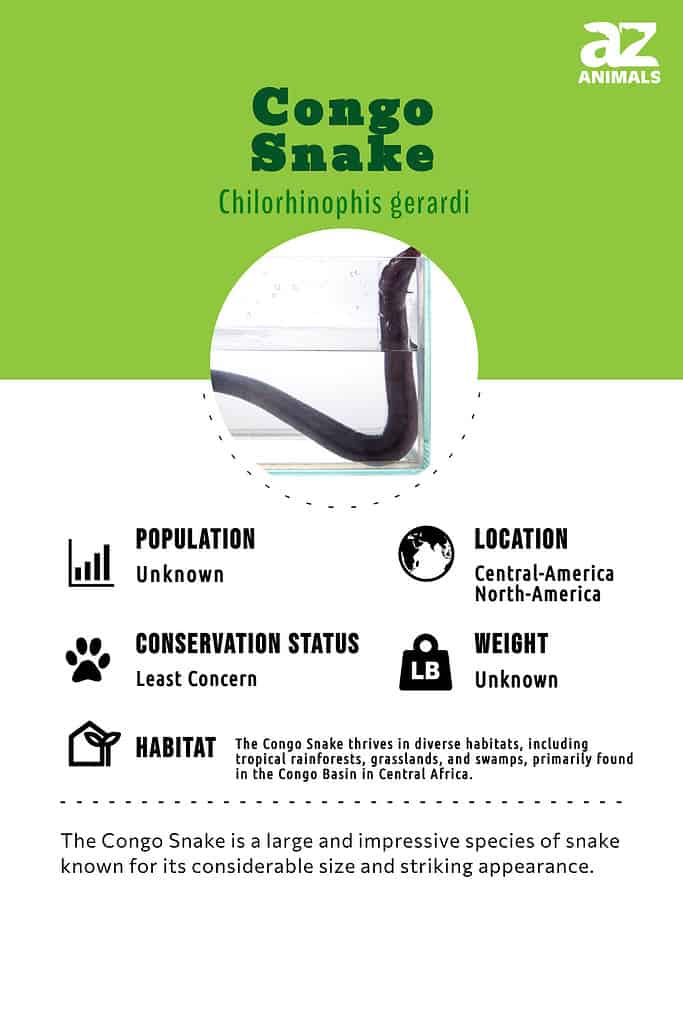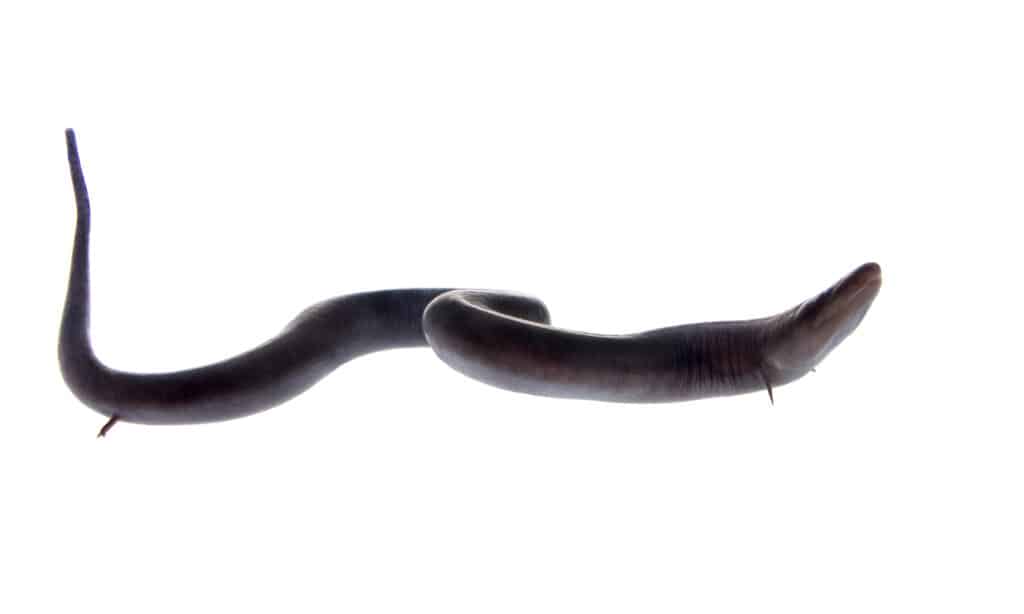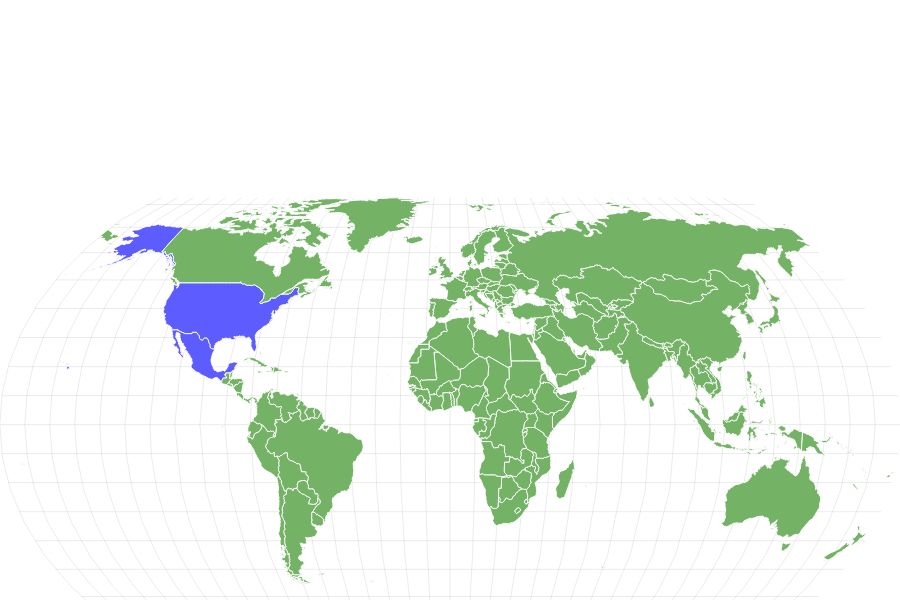Congo Snake
Advertisement
Congo Snake Scientific Classification
Read our Complete Guide to Classification of Animals.
Congo Snake Conservation Status
Congo Snake Facts
Congo Snake Physical Characteristics
- Color
- Grey
- Black
- Purple
- Lifespan
- Up to 27 years
- Length
- Up to 4 feet
- Venomous
- No
- Aggression
- Low
View all of the Congo Snake images!

Congo snake is the nickname for the amphiuma salamander. It is the largest salamander in the world.
The Congo snake is not actually a snake; it’s not even a reptile at all. It’s a genus of huge aquatic salamanders that resemble a snake.
There are currently three recognized species: the three-toed amphiuma, the two-toed amphiuma, and the one-toed amphiuma.
People also commonly refer to this animal as the Congo eel, even though it’s not closely related to fish at all. Needless to say, there is a lot of confusion surrounding the animal that this article will attempt to clarify.
5 Congo Snake Amazing Facts

Female lizards possess the capability of delaying fertilization, allowing them to retain sperm internally for extended periods before using it to fertilize their eggs.
©Rosa Jay/Shutterstock.com
- The mating season of the amphiuma takes place around the beginning of the year, usually January to April. Potential mates find each other through chemical means. Males usually court females by rubbing their snout against the female’s body. In the water, they will swim around each other and splash the surface of the water with their tails. If the female is interested, she will reciprocate these advances. Both males and females may have multiple mates every year.
- Females have the ability to delay fertilization. This means they keep sperm inside their bodies for several months before fertilizing the eggs. Up to 350 jelly-like eggs are laid on a single strand in wet mud, typically positioned in logs, branches, or burrows near the water’s edge. The mother will protect the eggs until they hatch about four or five months later. However, she does not provide much actual parental care.
- The amphiuma has an enormous amount of DNA in its cells. It is thought to be more than 25 times the amount of DNA contained in human cells. This is probably the result of the DNA duplicating itself over and over, but it’s not entirely clear what purpose this serves.
- The amphiuma has an average lifespan of 13 to 19 years in captivity with a maximum potential lifespan of 27 years. Their lifespan in the wild is not known. They become sexually mature at around three or four years of age.
- This salamander has the highest red blood cell count of any animal ever discovered. This makes it incredibly valuable to researchers as a so-called “model organism” (an organism that provides useful information about general biology).
Evolution and Origins
To locate the Conger Eel, players are advised to explore the Gale Cliffs region, specifically near the back area. Around map location O2, close to the upper part of the grid cell on the map, a dock with an unmarked campsite can be discovered, hosting fishing spots nestled within the rock channels.
The European conger (Conger conger) belongs to the Congridae family and is renowned as the largest and most weighty eel species globally, naturally inhabiting the northeast Atlantic region, including the Mediterranean Sea.
Where to Find Them
Despite the name, the Congo snake is actually endemic to many swampy locations, including marshes, bayous, lakes, streams, and even small ditches and pools, throughout the Southeastern United States. The one-toed amphiuma is found along the Gulf of Mexico. The two-toed amphiuma is found along the Gulf of Mexico coast and the Atlantic seaboard. The three-toed amphiuma is found from Louisiana in the south to Missouri in the north. They often seek out crayfish burrows and other kinds of dens in which to reside. They also spend the hot, dry summer in a state of relatively low activity.
Scientific Name
The scientific name of the Congo snake is Amphiuma. This may be derived from the Greek word pneuma, which means to breathe. This is combined with the prefix amphi- (which means both) to indicate it can breathe in both water and land. The Amphiuma genus is the only currently living member of its family. As mentioned previously, there are three separate species recognized in this genus.
Population and Conservation Status
According to the IUCN Redlist, both the three-toed and two-toed amphiuma are considered to be species of least concern. The one-toed amphiuma, by contrast, is near threatened. Habitat loss is a significant reason for decreased numbers. Swamps and wetlands are some of the most endangered habitats in the world. Water pollution may also contribute to a decline in many locations. Unfortunately, more precise population numbers have never been properly estimated.
How to Identify: Appearance and Description

The Congo snake is primarily recognized for its extraordinary dimensions, ranking prominently among the largest salamanders worldwide.
©Rosa Jay/Shutterstock.com
The Congo snake is most notable for its immense size. It is easily among the largest salamanders in the world. The long, cylindrical body, which features four vestigial legs (vestigial meaning reduced or limited usefulness), can reach up to 4 feet long.
The upper side of the body is covered in purplish gray or black skin. The underside is covered in a paler version of the same color. Other important characteristics include the strong jaws and sharp teeth. They also have rounded eyes on their flattened heads and a mouth that arcs almost into the shape of a smile.
The amphiuma or Congo snake has few easy-to-identify sexual characteristics. Males tend to be much larger than females, but overall they look remarkably similar to each other. Males and female amphibians do not have separate names like, say, a bull or a cow. Juveniles, on the other hand, look completely different.
Upon hatching from their eggs, undeveloped specimens begin life as mere tadpoles. These juveniles undergo a process known as incomplete metamorphosis. This means the adult continues to retain juvenile features after it has completed its transformation. Larvae lose their external gills about four months of age once the lungs begin to properly develop, but they still retain a pair of gill slits and a functioning set of internal gills. They also retain a flattened tail that enables them to easily swim through the water.
Here is how to identify the amphiuma or Congo snake:
Long, cylindrical body measuring up to 4 feet long
Four vestigial legs with one, two, or three toes (depending on the species)
Purple-colored gray or black upper side with a pale underside
A flattened tail
How Dangerous Are They?

The two-toed amphiuma, amphiuma means, isolated on white background
©Rosa Jay/Shutterstock.com
Congo snakes are not considered to be very dangerous. While they do have the ability to deliver a very painful bite with their strong jaws, there have never been any recorded attacks or adverse effects on humans. These salamanders would rather run away and hide. Due to their large size, they have few natural predators in the wild except perhaps for mud snakes, king snakes, and water moccasins. Tadpoles tend to have very high attrition numbers. Young adults may also be targeted by predators.
Behavior and Humans
Congo snakes are not normally encountered by humans. They are found deep within swampy waters where very few people venture. But on the rare occasions when people do interact with them, they are sometimes consumed as a delicacy and even kept as an exotic pet. They are not really sold anywhere or caught commercially, so you would have to catch one on your own.
View all 235 animals that start with CCongo Snake FAQs (Frequently Asked Questions)
Are Congo snakes venomous?
They are not venomous at all.
How do Congo snakes hunt?
The Congo snake is an ambush predator. It remains in the burrow with only the head visible and strikes out at prey that passes by. Sometimes it will leave the burrow to hunt for food and even pursue its prey over short distances, but it generally doesn’t venture very far. With its powerful jaw and sharp teeth, the animal will bite its prey and tear off pieces of flesh to consume as food. The period of their greatest activity is around midnight. Their bodies are sometimes seen covered in bite marks. This is thought to be the result of foraging activities and not predatory attacks or mating behavior.
Are Congo snakes aggressive?
They are not considered to be aggressive toward humans at all, but they do have a very powerful bite that could potentially do some damage. They usually do not bite unless directly threatened.
Where do Congo snakes live?
They live in swampy wetland habitats, including bayous, marshes, lakes, and streams.
What do Congo snakes eat?
All three species have a very diverse diet that consists of many different types of foods, including consists of insects, worms, snails, fish, crayfish, and other reptiles and amphibians. Cannibalism has sometimes been observed to occur.
Where are Congo snakes found?
They are found in many locations throughout the Southeastern United States.
How big is the Congo snake?
It measures up to 4 feet in size from head to tail.
What is the Congo snake?
The name of Congo snake (as well as Congo eel) is actually a misnomer. This is not really a snake at all. It’s a type of salamander. The mistake probably comes from the fact that the body is incredibly long and slender like a snake.
Thank you for reading! Have some feedback for us? Contact the AZ Animals editorial team.


















